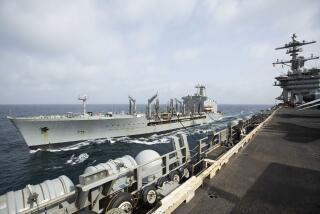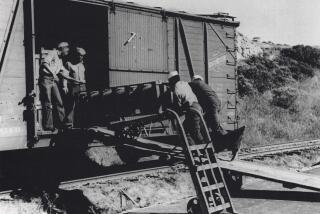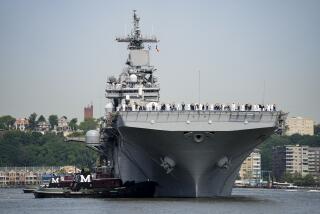Safe at Home : War aftermath: The Tripoli is welcomed back to its San Diego port. The ship was the only U.S. vessel damaged in the Persian Gulf.
- Share via
SAN DIEGO — The Tripoli, the only U.S. Navy ship to suffer major combat damage in Operation Desert Storm, returned home Thursday, more than eight months after being deployed to the Persian Gulf.
Despite a 20-by-30-foot hole caused by the explosion of an Iraqi mine Feb. 18, the 25-year-old ship continued its mission for five days until it ran out of fuel for its mine-sweeping helicopters.
The Naval Historical Center in Washington reported that the Tripoli is the first U.S. Navy ship since the Civil War to suffer major mine damage and continue with its mission.
The Tripoli, with its crew of 1,100 sailors and Marines, steamed into San Diego’s 32nd Street Naval Station at 8:45 a.m. Thursday, ending a homeward journey that began June 23.
The crew members stepped off the ship into a sea of red, white and blue balloons and banners, but some family members complained that the lengthy tour of duty robbed the crew of much of the hoopla that surrounded earlier welcome-home celebrations.
“All the guys who got back earlier got the parades. These guys aren’t getting anything, zero,” said Julie Lawrence, 29, of Santee, who was waiting for her husband, Guy Lawrence, 22, a missile technician, to disembark. “We’re the only ones who will get to greet them. It’s not fair to them. The parades were held too early. The country should’ve waited for everyone to get back before putting on the parades.”
Despite such concerns, the mood of the crew and its commanding officers was decidedly upbeat.
Capt. G. Bruce McEwen, the ship’s skipper, praised his young crew for keeping the Tripoli battle-ready while repairing damage caused by the 320-pound mine. McEwen, a USC graduate and native of Ontario, said the crew’s average age is 21 1/2.
“There was no screaming, no yelling. Our young sailors began to limit the flooding,” said McEwen in a pier-side interview. “They were very professional. The country should be very proud of them. They represent a cross-section of the youth of America.”
Four sailors suffered minor injuries in the explosion, which occurred shortly after 4:30 a.m. about 10 feet below the water line on the starboard side. The explosion left the 686-foot ship dead in the water for most of the day, while crew members did preliminary repairs and pumped out flooded areas.
The Tripoli was the flagship for mine-clearing operations in the northern Persian Gulf. On the day of the explosion, it was the lead ship in a battle group that had been targeted by the Iraqis for attack with Silkworm missiles, McEwen said.
The ships were in an area off the Kuwaiti coast thought to be mine-free and were more concerned with the Silkworm threat, he said.
“We had not detected any mines and were preparing to declare the area to be mine-free, when the explosion occurred. . . . We went dead in the water because we were unsure of the extent of the damage,” McEwen said.
Chief Robert Murphy told the Associated Press he knew exactly what was happening when he was jolted awake by the “tremendous blast” of the ship striking the moored Iraqi mine.
“When it happens you’ll know it and you’ll never forget it,” Murphy said.
After the explosion, the ship dropped anchor and crew members worked for 9 1/2 hours to repair the damage.
Later that evening, German, Japanese and U.S. minesweepers cleared a channel that allowed the Tripoli and its helicopters to continue clearing the area of mines. About 21 Iraqi mines were destroyed by the Tripoli’s ordnance teams, which were dropped next to the mines by helicopter.
More to Read
Sign up for Essential California
The most important California stories and recommendations in your inbox every morning.
You may occasionally receive promotional content from the Los Angeles Times.










